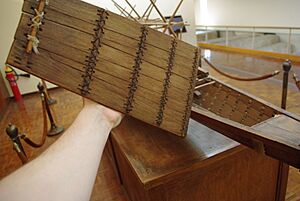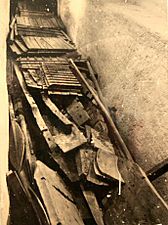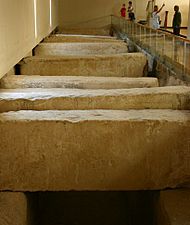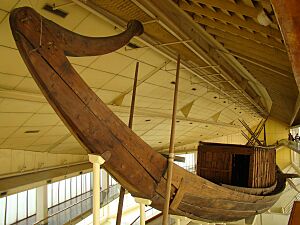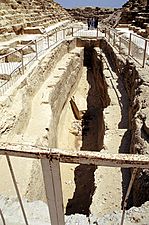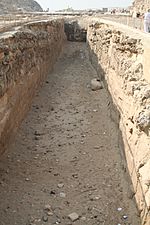Khufu ship facts for kids
Quick facts for kids Khufu ship |
|
|---|---|
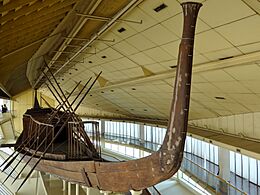
The reconstructed "solar barge" of Khufu
|
|
| Type | Solar barque |
| Material | Lebanon cedar |
| Long | 43.4 metres (142 ft) |
| Width | 5.9 metres (19 ft) |
| Created | c. 2500 BC |
| Discovered | 1954 Giza pyramid complex |
| Discovered by | Kamal el-Mallakh |
| Present location | Grand Egyptian Museum |
| Culture | Ancient Egypt |
The Khufu ship is an amazing ancient Egyptian boat. It was found sealed in a special pit next to the Great Pyramid of Pharaoh Khufu. This happened around 2500 BC, during a time called the Old Kingdom in ancient Egypt.
Ancient Egyptians believed their pharaohs needed many things for the afterlife. So, they buried items like this ship as grave goods. The Khufu ship is one of the oldest, largest, and best-kept boats from ancient times. It is 43.4 metres (142 ft) long and 5.9 metres (19 ft) wide. Experts say it's a "masterpiece of woodcraft." It could even sail today if it were put in water!
The ship used to be in the Giza Solar boat museum. But in August 2021, it was carefully moved to the Grand Egyptian Museum.
Contents
What Was the Khufu Ship Used For?
A Special Boat for the Pharaoh
We don't know exactly why the Khufu ship was built. It's a type of boat called a "solar barge." Ancient Egyptians thought these boats would carry the pharaoh's spirit across the sky with the sun god Ra.
However, the ship also shows signs that it might have been used in water. Some people think it was a "funerary barge." This means it could have carried Khufu's body from Memphis to Giza for burial. Others believe Khufu himself used it as a "pilgrimage ship" to visit holy places. Then, it was buried so he could use it again in the afterlife. Unlike some other ancient ship burials, no bodies were found inside the Khufu ship.
How Was the Khufu Ship Found?
Discovery of the Ancient Vessel
The Khufu ship was one of two boats found in 1954 by an archaeologist named Kamal el-Mallakh. It had been sealed in a pit carved into the rock near the pyramid. No one had touched it for thousands of years!
The ship was mostly made from Lebanon cedar wood. It was built using a special method where the outer planks were put together first. The pieces were held with strong wooden pegs. The ship has a flat bottom made of several planks, but no deep keel. The planks and frames were tied together with Halfah grass.
Rebuilding the Ship
The ship was found in 1,224 separate pieces. These pieces were laid out in a careful, organized way in the pit. It took many years to put the boat back together. The main person in charge of this huge task was Ahmed Youssef Moustafa. He was the chief restorer for the Egyptian Department of Antiquities.
Before starting, Moustafa studied ancient Egyptian boatbuilding. He looked at pictures carved on walls and tombs. He also studied small wooden boat models found in other tombs. He even visited modern boatyards in Egypt. He hoped to learn old shipbuilding methods that might still be used today.
Where Can You See the Khufu Ship?
Exhibition and Relocation
The Khufu ship was first put on display in 1982. A special museum was built for it right next to the Great Pyramid in Giza. The first floor of the museum showed visitors how the boat was found and put back together. You could even see the original pit where the boat was discovered.
To see the amazing restored boat, visitors would go up to the second floor. Big windows let in lots of sunlight. A wooden walkway went all around the boat, so you could see its impressive size up close.
In August 2021, the Khufu ship was carefully moved to its new home. It is now on display at the Grand Egyptian Museum.
Gallery
-
Solar boat pit, Giza Plateau, Egypt
See also
 In Spanish: Barca funeraria de Keops para niños
In Spanish: Barca funeraria de Keops para niños
- Atet
- Abydos boats
- Ancient Egyptian technology
- Dahshur boats
- Ships preserved in museums


